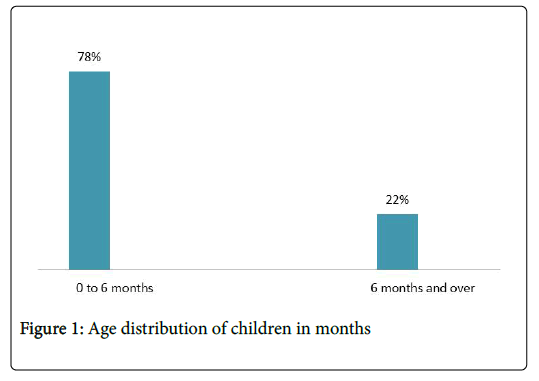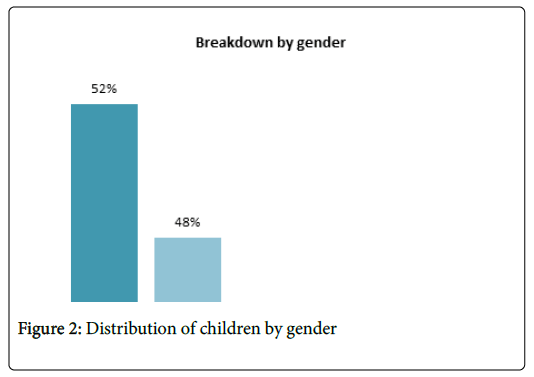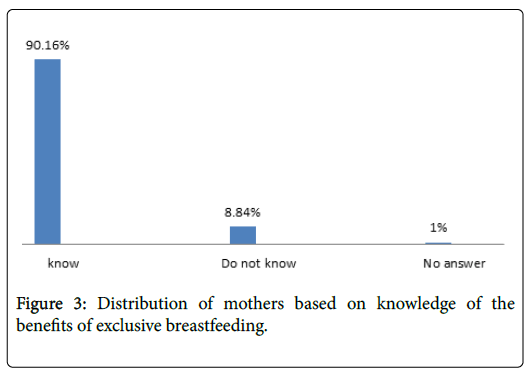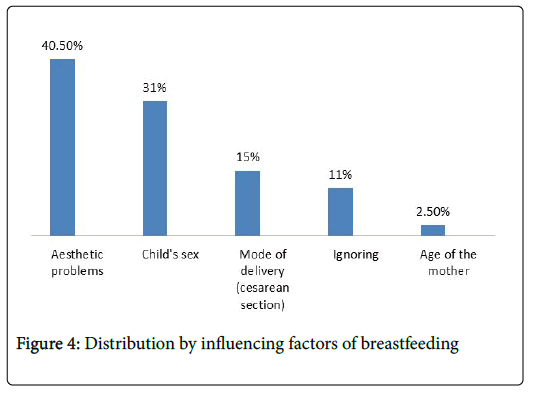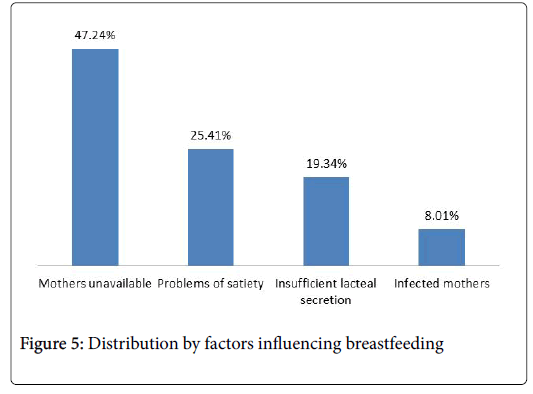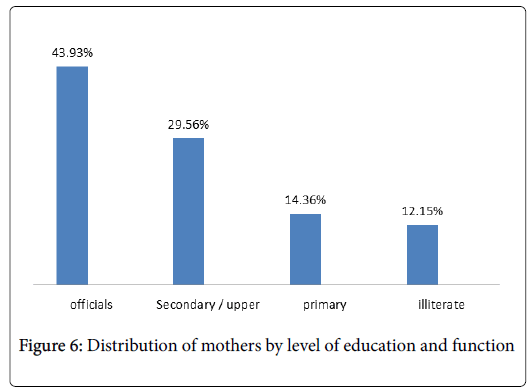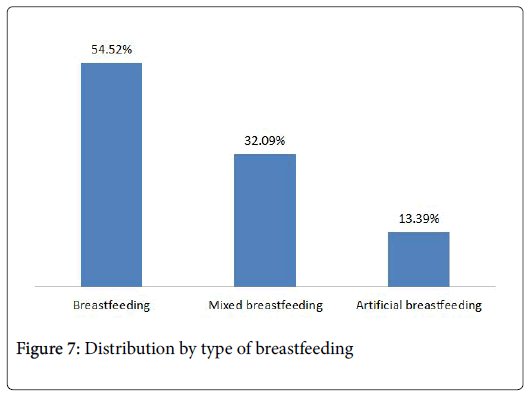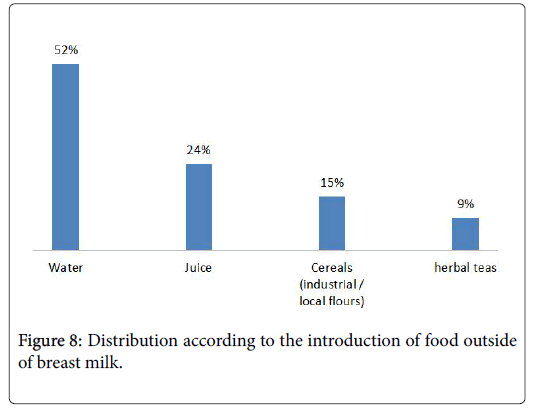Evaluation of Factors Influencing Breastfeeding in Children Aged 0 to 24 Months Received in an Urban Community Health Center in Abidjan Cocody (Cote d'Ivoire)
Received: 13-Nov-2018 / Accepted Date: 26-Nov-2018 / Published Date: 03-Dec-2018 DOI: 10.4172/2165-7386.1000348
Abstract
Purpose: The aim of this study is to evaluate the factors influencing breastfeeding among children aged 0 to 6 months received in an urban community health center in Abidjan Cocody (Côte d'Ivoire).
Methods: To do this, a cross-sectional and analytical study was conducted in the Anono Urban Community Health Service with 362 mothers interviewed using survey cards. The socio-economic characteristics, the choice of breastfeeding, the type of breastfeeding influencing breastfeeding were studied. The study ran from March to April 2018. The data was processed using Excel 2007.
Results: The results showed that some factors hinder exclusive breastfeeding. Mothers' function was an impediment to exclusive breastfeeding, 43.93% were civil servants and 29.56% were students and 26.51% were housewives or shopkeepers. In our study, more than 40% of mothers did not practice exclusive breastfeeding for a cosmetic problem, 31% were related to the sex of the baby, 15% associated with caesarean delivery, 11% for low education level and 2.5% because of the age of the mother. Among the civil servant mothers, or students, 100% practiced mixed breastfeeding. Overall (362) of the mothers surveyed, over 54% practiced mixed breastfeeding. The majority of these mothers introduced water (52%), fruit juice (24%), cereals (15%) and herbal teas at 9%. More than 47% were unable to practice exclusive breastfeeding for the first six months. In this study there is a problem of satiety at 25.41%, insufficient milk secretion 19.34% and other conditions contraindicated for exclusive breastfeeding.
Conclusion: The factors of the non-practice of exclusive breastfeeding were low education level, function, early introduction of solid foods, aesthetic problem, and unavailability of time of mothers, satiety problem, insufficient milk secretion and conditions for breastfeeding. These factors will have to be taken into account in the strategy to increase the rate of exclusive breastfeeding and its continuation up to six months in mothers in communes where the standard of living is relatively high.
Keywords: Mixed breastfeeding; Food introduction; Influencing factors
Introduction
Current breastfeeding models remain well below the recommended level and vary considerably from region to region [1]. International organizations (WHO, UNICEF) are multiplying initiatives to promote and support breastfeeding. In developing countries, feeding practices are very often inadequate and incompatible with World Health Organization (WHO) recommendations and are the main factors affecting the physical growth and mental development of the child [2]. Poor nutritional status on early childhood also affects health in adulthood [3].
In West Africa, the protection, promotion and support of exclusive breastfeeding in the first six months of life is recognized as the most important strategy for reducing infant and child mortality. However, the rate of breastfeeding in the region is 20% and remains among the lowest in the world [4].
Problems related to breastfeeding occur in both West Africa and Côte d’Ivoire. Indeed, despite the existence of recommendations on the promotion of exclusive breastfeeding, some nutritional practices are inappropriate and have consequences for infant health (EDSCI, 2016) and would be the basis of malnutrition among children in age’s preschool [5]. WHO and UNICEF recommend exclusive breastfeeding for the first 6 months [6]. It provides daily intake of calories, micronutrients and water and it has the distinction of changing according to the needs of the infant [7]. In 2016, the percentage of infants under six months exclusively breastfed is 23.5% in Côte d’Ivoire (MICS, 2016). Despite the efforts of the Ministry of Health of Côte d’Ivoire and its partners, the practice of breastfeeding faces obstacles. Therefore, it is important to study the environmental context of infant feeding with breastfeeding mothers. The purpose of this study is to evaluate the factors influencing breastfeeding in children aged 0 to 24 months.
Methods
The survey was conducted in the Urban Community Health Service of Anono: 362 mothers were interviewed. The selection of the mothers for the study was made according to the place of residence in the commune of Cocody (Abidjan). The questionnaire asks about the mother's occupation, level of education, choice of breastfeeding, type of breastfeeding, mother's profession and age of introduction of food other than breast milk. The study ran from March to April 2018. The data was processed using Excel 2007. The survey did not begin until consent was obtained from the mother
Results
Age distribution of the children
Children aged between 0 to 6 months are the most in number with more than 77% as shown in Figure 1.
Distribution of children by sex
According to this distribution, girls are more numerous with 52% and boys with 48% as shown in Figure 2.
Distribution of mothers according to their knowledge of the benefits of exclusive breastfeeding
The benefits of breastfeeding were known to 90% of mothers as shown in Figure 3.
Distribution of mothers by factors influencing breastfeeding
In this study, the inter-factorial analysis of our survey reveals the following observations: Of the 362 mothers or 40.50% do not practice exclusive breastfeeding for a cosmetic problem, 31% related to the sex of the baby, 15% associated with caesarean delivery, 11% for ignorance and 2.5% because of mother's age as depicted in Figure 4.
Distribution by influencing factors of breastfeeding
Distribution of mothers by breastfeeding method and the reason for this choice
Several factors impact the practice of exclusive breastfeeding, which is due to 47.24% of the unavailability of mothers, 25.41% to the problem of satiety, 19.34% to insufficient milk secretion and 8% due to breastfeeding mothers as depicted in Figure 5.
Distribution of mothers by level of education
Women civil servants are the most represented with more than 43% seconded by students 29.56% as show in Figure 6. It is found that it is mothers who have a primary or illiterate level who practice more breastfeeding. Conversely, public servants or students are the most to have adopted mixed breastfeeding.
Distribution by type of breastfeeding
In this study, mixed breastfeeding is the most commonly performed with over 54% as shown in Figure 7.
Distribution according to the period of introduction of complementary food
The majority of mothers introduced water at 52%, fruit juice (24%), cereals (15%) and herbal teas at 9% as depicted in Figure 8.
Discussion
This study was conducted to help improve exclusive breastfeeding for the 6 first months. In our study, the age group 0 to 6 months is the most represented with a rate of 77.90%. Most of the children in this study were in their first six months of life. This could be explained by the fact that in this age group, there are several vaccines to be done in the hospital. In this study, the girl-to-boy ratio was 1.08. This shows that there are more girls than boys. This configuration of the girl-boy ratio is similar to the population of the city of Abidjan (RGPH, 2016). This result agrees with those of Egnon et al. in their study on the neglect of stunting in children, in contrast to those of Kanté and Traoré [8,9]. Among the factors that influence the practice of breastfeeding, there is a lack of knowledge of the benefits of mothers on breastfeeding. In this study, mothers have the knowledge of the benefits of breastfeeding estimated at 90.11%. This is justified by the fact that these mothers reside in Cocody Abidjan and are mostly high education level. These findings are consistent with those of Bonetto- Cadoret who found that mothers' knowledge of the benefits of breast milk was a motivation for them to continue exclusive breastfeeding [10].
The inter-factor analysis of our survey revealed the following findings: Of the 362 mothers or 40.50% do not practice exclusive breastfeeding for a cosmetic problem. This result is contrary to that of Houssaini et al. [11]. In fact, in our study some mothers refuse to breastfeed the baby for a long time so that they do not have flabby breasts and remain always beautiful. In addition, 31% of mothers practice mixed breastfeeding because of their baby's gender. According to them, male children suckle much more and breast milk is not enough for them. This result is similar to that of Bellati-Saadif et al. who found that boys suckle than girls. In this study, 15% of mothers delivered by caesarean section [12]. It has been identified as a factor of choice for mixed breastfeeding. This result is in agreement with that of Houssaini et al. The lack of knowledge of young mothers about the duration of breastfeeding is a problem in the practice of exclusive breastfeeding. In this study, primiparous mothers do not know the duration of breastfeeding and illiterate mothers. However, the lack of information on optimal breastfeeding time is a barrier to breastfeeding [13]. This result is similar to that of Coulibaly et al. in their study on the socio-professional factors and practice of exclusive breastfeeding by primiparous women in Abidjan (Ivory Coast) [14]. Although they know that breast milk is the best food for the infant and that it is beneficial for its optimal development, the duration of breastfeeding is not respected [15].
In this study, the overall rate of breastfeeding practice regardless of the child's age was 32.09%. Indeed, this rate is substantially similar to that of Coulibaly et al. which was 33.51%. As in their study, there is a gradual decrease in the practice of breastfeeding from 1 to 6 months. This decrease in breastfeeding rate during child growth has been found in several studies, notably in the Demographic and Health and Multiple Indicator Survey (EDS-MICS, 2011-2012, MICS, 2017) [16].
Breastfeeding, in addition to the many benefits it brings to children, has many other benefits. In fact, long-term breastfeeding helps to reduce the infant mortality rate and to space births [6]; it reduces the risk of breast and uterine cancer [17]. For this reason, WHO and UNICEF recommend exclusive breastfeeding for the first six months of life [18]. According to these experts, the continuation of exclusive breastfeeding during the first six months allows optimal development of infants and should be encouraged.
Mixed breastfeeding is the most common practice among mothers surveyed in our study with over 54%. This is justified by the fact that in this area of Cocody, parents have the means to buy infant milks. In this study, it was found that some mothers bought infant milks without the advice of a specialist, which is clear from cases of constipation in infants. The frequent use of infant milks is due to the fact that Cocody is a residential community where most of the public or private employees live [14]. These results are in agreement with those of Nlend et al. [19]. In their studies, breast-milk substitutes were one of the key factors impeding the success of breastfeeding. Mixed feeding, bringing water or any other liquid, can also cause a decrease in the production of breast milk or cause the baby to reject the breast. In addition, mixed feeding increases the risk of HIV transmission from mother to child. Indeed, exclusive breastfeeding for up to six months reduces the risk of HIV transmission compared to a compound diet (breast milk and other foods) in several African studies [20].
The practice of mixed breastfeeding is associated with the introduction of foods other than milk. In fact, in this study mothers introduced water at 52%, fruit juice 24%, cereals 15% and herbal teas at 9%. The use of water is linked to the consumption of infant milks or mothers are sometimes obliged to give water to infants. Hence the importance of using exclusive breast milk that contains a large amount of water sufficient for the needs of the child [20]. On the other hand, some mothers think that breast milk does not slake the thirst of the child and that it is necessary to give water or sometimes even herbal teas to ensure good health. Others report low breast milk production of 19.34%. Moreover, during this study, a mother revealed that "my child cries a lot, he is thirsty and even after the feedings, another replica me my mother gave me water when, I was my baby's age so my child has to drink water''. These comments were more collected from illiterate mothers in this study. This indicates an attachment to customary and traditional practices that are often in contradiction with the recommendations of the WHO, but especially a lack of information on the appropriate feeding practices for infants. This same observation was made by Sanogo K during his study [7]. Yet, many studies have shown that breast milk alone covers all the needs of the child from birth to 6 months of age and ensures good health, physical and intellectual development [18,21,22]; As for the consumption of fruit juices, especially orange juice is linked to the fact that most infants using milk substitutes are constipated. They therefore use the fruit juice to facilitate intestinal transit. These results confirm those of Sanogo K who claimed that mothers gave other foods in addition to breast milk [7]. The use of cereals is associated with the problem of satiety of infants.
In fact, 43.93% of public servants and 29.56% of mother students face barriers in the practice of exclusive breastfeeding. This is because mothers leave early for school or work and return home late at night. Work is the most important factor preventing good breastfeeding practice. This finding has been made by several authors Sibeko et al. and Kouassi et al. [23,24]. Indeed, the work of the mother negatively influences the duration of breastfeeding. In this study, some mothers interviewed say that they want to continue to breastfeed their baby, but they have no choice to use the bottle because of work and their unavailability (47.24%). Moreover, this situation is linked to the fact that in Côte d'Ivoire, the Labor Code remains unfavorable to the practice of exclusive breastfeeding because it gives mothers only 14 weeks of maternity leave and one hour breastfeeding time per workday [14]. In addition, during the absence of student mothers and officials infants are entrusted to nannies who sometimes do not respect the conditions of hygiene during the preparation of the bottle and causing diarrhea in infants. More than 57% of cases were identified by the mothers interviewed.
Conclusion
The results of our study show that the practice of exclusive breastfeeding among mother’s civil servants and students remains low in Cocody. Several factors influence the practice of exclusive breastfeeding. There is the level of knowledge of the benefits of exclusive breastfeeding and duration, insufficient milk secretion, conditions contraindicated for breastfeeding, the function of the lactating mothers, the mother's education level and the early introduction of food.
While health workers in all its components do a remarkable job, but based on our findings and previous studies, health workers and partners need to continue to raise awareness about the practice of exclusive breastfeeding until at six months and the prosecution up to two years.
References
- Dakouré Pegde-bamba C (2012) Exclusive breastfeeding as a method of contraception: study of the method of breastfeeding and amenorrhea (LAM) in two medical centers in the city of Ouagadougou. University of Ouagadougou. For the degree of Doctor of Medicine. 116.
- Triaa Behammadi I (2009) Determinants of choice of breastfeeding: prospective study of 111 women at Max Fourestier's maternity clinic in Nanterre [Thesis for the doctorate in medicine]. Paris: University Paris Diderot 173 p.
- Dubois L, Girard M (2003) Social Determinants of initiation, duration and exclusivity of breastfeeding at the population level: The result of the longitudinal study of child development in Quebec (ELDEC 1998-2002). Can J Public Health 94: 300-305.
- Sokol E, Aguayo VM, Clark D (Protect breastfeeding in West and Central Africa. 25 years of application of the International Code on the Marketing of Breastmilk Substitutes. Dakar: UNICEF ​​- Regional Office for West and Central Africa; 2007. 44.
- Demographic and Health Survey of Côte d'Ivoire. 2011-2012. (EDSCI-III 2011- 2012). National Statistical Institution (INS) 38.
- Sanogo K (2011) Knowledge and practices of mothers with regard to feeding early childhood in the village of point g in commune iii of Bamako district University of Bamako (Mali). 70.
- Kouakou EK, Kamara SM, Zannou-Tchoko V, Meite A, Bouafou KG, et al. (2017) Neglected growth retardation in children aged 6-59 months in developing countries: Case of a subneighborhood of Abidjan Cocody - Ange (Ivory Coast). Sci J of Pub Healt 5: 8-12.
- Traoré BM (2015) Evaluation of the nutritional status of children aged 0-59 months in the CSRéf and the two CSCom of the city of TOMBOUCTOU thesis of medicine.
- Bonetto-Cadoret E (2015) Factors influencing the fate of breastfeeding when the mother's work is resumed: A qualitative study by individual interviews with mothers returning to work before the 6 months of their child working in the Alpes-Maritimes and is Var. Human medicine and pathology.
- Houssaini ZS, Inekac S, Hassani MB, Ouhssine M, Guessous Z (2017) Current situation and factors influencing breastfeeding in rabat city, morocco, About a Survey of 275 Mothers. Euro Sci J 13: No.9 P194
- Saadif B, Sallm G, Martins L, Azondekona, Kuakuvi N (1996) Current situation of breastfeeding in the region of Agadir in Morocco about a survey of 220 mothers. Med of Black Africa 43.
- Taveras EM, Li R, Grummer-Strawn L, Richardson M, Marshall R, et al. (2004) Opinions and practices of clinicians associated with the continuation of exclusive breastfeeding. Pediatrics 113: e283-e290.
- Coulibaly A, Tano OA, Bi Vroh JB, Y Traoré, Dagnan NS (2014) Socioprofessional factors and practice of exclusive breastfeeding by primiparous women in Abidjan (Ivory Coast). Public Health 26: 555-562.
- Elbakali M (2011) The practice of breastfeeding at the level of three maternity wards: current situations and influencing factors, survey of 227 mothers and 61 health professionals (2011). Thesis of medicine. Mohammed V-Souissi University Faculty of Medicine and Pharmacy-RABAT. 168.
- National Institute of Statistics, ICF International. Demographic and Health Survey and Multiple Indicators (EDS-MICS) 2011-2012. Abidjan: INS, Calverton (MA): ICF International, 2013, 591.
- Tryggvadottir L, Tulinius H, Eyfjord J, Sigurvinsson T (2001) Breastfeeding and reduced risk of breast cancer in an icelandic cohort study. Am J Epidemiol 154: 37-42.
- Nlend A, Wamba G, Same C Ekobo (1997) Infant feeding from 0 to 36 months in Cameroonian urban areas. Medi of Black Africa: 44.
- UNICEF (2015) Breastfeeding-Nutrition, impact on child survival and situation in the world: 3.
- Bachrach VR, Schwarz E, Bachrach LR (2003) Breastfeeding and the risk of hospitalization for respiratory disease in infancy. Arch Pediatr Adolesc Med 157: 237-243.
- Oddy WH (2002) The impact of breast milk on infant and child health. Breastfeed Rev 10: 5-18.
- Kouassi KF, Aké-Tano O, Yéo A (2012) Feeding children from 0 to 6 months of primiparous mothers in urban Ivorian. Biomed Africa 17: 80-86.
- Sibeko L, Dhansay MA, KE Charlton, Johns T, Gray Donald K (2005) Beliefs, attitudes, and practices of breastfeeding mothers in South Africa. J Hum Lact 21: 31-38.
Citation: Mouroufie AKJ, Kouakou EKV, Kouakou Firmin K, Tanoh F. Ebou, Kouakou AC, et al. (2019) Evaluation of Factors Influencing Breastfeeding in Children Aged 0 to 24 Months Received in an Urban Community Health Center in Abidjan Cocody (Côte d'Ivoire). J Palliat Care Med 9: 348 DOI: 10.4172/2165-7386.1000348
Copyright: © 2018 Mouroufie AKJ, et al. This is an open-access article distributed under the terms of the Creative Commons Attribution License, which permits unrestricted use, distribution, and reproduction in any medium, provided the original author and source are credited.
Select your language of interest to view the total content in your interested language
Share This Article
Recommended Journals
Open Access Journals
Article Tools
Article Usage
- Total views: 4414
- [From(publication date): 0-2019 - Dec 06, 2025]
- Breakdown by view type
- HTML page views: 3490
- PDF downloads: 924

